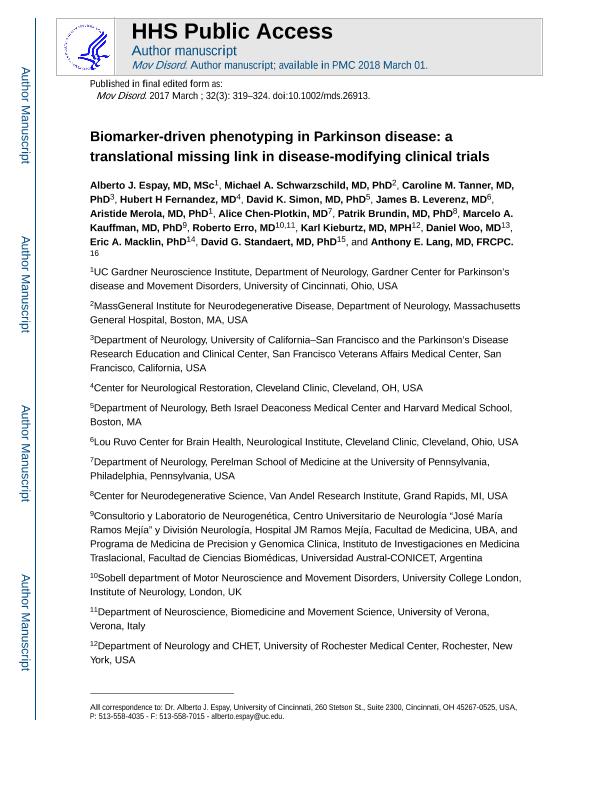Mostrar el registro sencillo del ítem
dc.contributor.author
Espay, Alberto J.
dc.contributor.author
Schwarzschild, Michael A.
dc.contributor.author
Tanner, Caroline M.
dc.contributor.author
Fernandez, Hubert H.
dc.contributor.author
Simon, David K.
dc.contributor.author
Leverenz, James B.
dc.contributor.author
Merola, Aristide
dc.contributor.author
Chen Plotkin, Alice
dc.contributor.author
Brundin, Patrik
dc.contributor.author
Kauffman, Marcelo Andres

dc.contributor.author
Erro, Roberto
dc.contributor.author
Kieburtz, Karl
dc.contributor.author
Woo, Daniel
dc.contributor.author
Macklin, Eric A.
dc.contributor.author
Standaert, David G.
dc.contributor.author
Lang, Anthony E.
dc.date.available
2018-04-03T18:06:04Z
dc.date.issued
2017-03
dc.identifier.citation
Espay, Alberto J.; Schwarzschild, Michael A.; Tanner, Caroline M.; Fernandez, Hubert H.; Simon, David K.; et al.; Biomarker-driven phenotyping in Parkinson's disease: A translational missing link in disease-modifying clinical trials; Wiley-liss, Div John Wiley & Sons Inc; Movement Disorders; 32; 3; 3-2017; 319-324
dc.identifier.issn
0885-3185
dc.identifier.uri
http://hdl.handle.net/11336/40514
dc.description.abstract
Past clinical trials of putative neuroprotective therapies have targeted PD as a single pathogenic disease entity. From an Oslerian clinicopathological perspective, the wide complexity of PD converges into Lewy bodies and justifies a reductionist approach to PD: A single-mechanism therapy can affect most of those sharing the classic pathological hallmark. From a systems-biology perspective, PD is a group of disorders that, while related by sharing the feature of nigral dopamine-neuron degeneration, exhibit unique genetic, biological, and molecular abnormalities, which probably respond differentially to a given therapeutic approach, particularly for strategies aimed at neuroprotection. Under this model, only biomarker-defined, homogenous subtypes of PD are likely to respond optimally to therapies proven to affect the biological processes within each subtype. Therefore, we suggest that precision medicine applied to PD requires a reevaluation of the biomarker-discovery effort. This effort is currently centered on correlating biological measures to clinical features of PD and on identifying factors that predict whether various prodromal states will convert into the classical movement disorder. We suggest, instead, that subtyping of PD requires the reverse view, where abnormal biological signals (i.e., biomarkers), rather than clinical definitions, are used to define disease phenotypes. Successful development of disease-modifying strategies will depend on how relevant the specific biological processes addressed by an intervention are to the pathogenetic mechanisms in the subgroup of targeted patients. This precision-medicine approach will likely yield smaller, but well-defined, subsets of PD amenable to successful neuroprotection.
dc.format
application/pdf
dc.language.iso
eng
dc.publisher
Wiley-liss, Div John Wiley & Sons Inc

dc.rights
info:eu-repo/semantics/openAccess
dc.rights.uri
https://creativecommons.org/licenses/by-nc-sa/2.5/ar/
dc.subject
Biomarkers
dc.subject
Neuroprotection
dc.subject
Parkinson'S Disease
dc.subject
Systems Biology
dc.subject
Parkinson'S Disease
dc.subject.classification
Medicina Critica y de Emergencia

dc.subject.classification
Medicina Clínica

dc.subject.classification
CIENCIAS MÉDICAS Y DE LA SALUD

dc.title
Biomarker-driven phenotyping in Parkinson's disease: A translational missing link in disease-modifying clinical trials
dc.type
info:eu-repo/semantics/article
dc.type
info:ar-repo/semantics/artículo
dc.type
info:eu-repo/semantics/publishedVersion
dc.date.updated
2018-03-27T15:15:04Z
dc.journal.volume
32
dc.journal.number
3
dc.journal.pagination
319-324
dc.journal.pais
Estados Unidos

dc.journal.ciudad
Nueva York
dc.description.fil
Fil: Espay, Alberto J.. University of Cincinnati; Estados Unidos
dc.description.fil
Fil: Schwarzschild, Michael A.. Massachusetts General Hospital; Estados Unidos
dc.description.fil
Fil: Tanner, Caroline M.. University of California; Estados Unidos
dc.description.fil
Fil: Fernandez, Hubert H.. Cleveland Clinic; Estados Unidos
dc.description.fil
Fil: Simon, David K.. Harvard Medical School; Estados Unidos
dc.description.fil
Fil: Leverenz, James B.. Cleveland Clinic; Estados Unidos
dc.description.fil
Fil: Merola, Aristide. University of Cincinnati; Estados Unidos
dc.description.fil
Fil: Chen Plotkin, Alice. University of Pennsylvania; Estados Unidos
dc.description.fil
Fil: Brundin, Patrik. Van Andel Research Institute. Center for Neurodegenerative Science; Estados Unidos
dc.description.fil
Fil: Kauffman, Marcelo Andres. Universidad Austral; Argentina. Universidad Austral. Facultad de Ciencias Biomédicas. Instituto de Investigaciones en Medicina Traslacional. Consejo Nacional de Investigaciones Científicas y Técnicas. Oficina de Coordinación Administrativa Parque Centenario. Instituto de Investigaciones en Medicina Traslacional; Argentina. Gobierno de la Ciudad de Buenos Aires. Hospital General de Agudos "Ramos Mejía"; Argentina
dc.description.fil
Fil: Erro, Roberto. Universita di Verona; Italia. University College London; Reino Unido
dc.description.fil
Fil: Kieburtz, Karl. University of Rochester Medical Center; Estados Unidos
dc.description.fil
Fil: Woo, Daniel. University of Cincinnati; Estados Unidos
dc.description.fil
Fil: Macklin, Eric A.. Massachusetts General Hospital; Estados Unidos
dc.description.fil
Fil: Standaert, David G.. University of Alabama at Birmingahm; Estados Unidos
dc.description.fil
Fil: Lang, Anthony E.. University of Toronto; Canadá
dc.journal.title
Movement Disorders

dc.relation.alternativeid
info:eu-repo/semantics/altIdentifier/doi/http://dx.doi.org/10.1002/mds.26913
dc.relation.alternativeid
info:eu-repo/semantics/altIdentifier/url/https://onlinelibrary.wiley.com/doi/abs/10.1002/mds.26913
Archivos asociados
